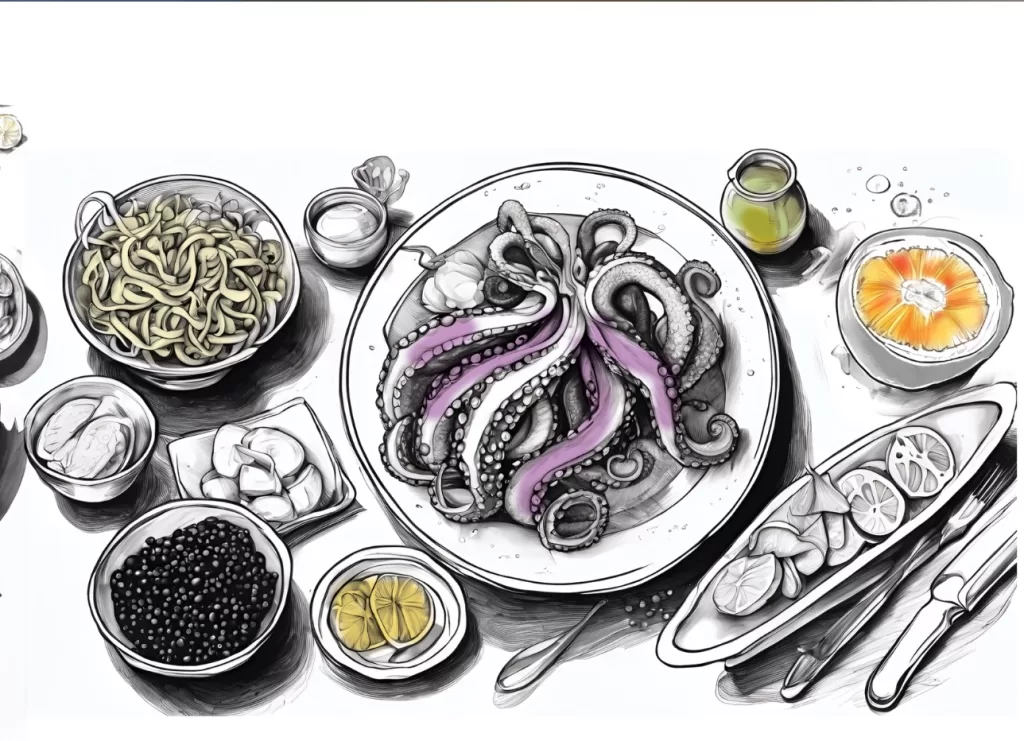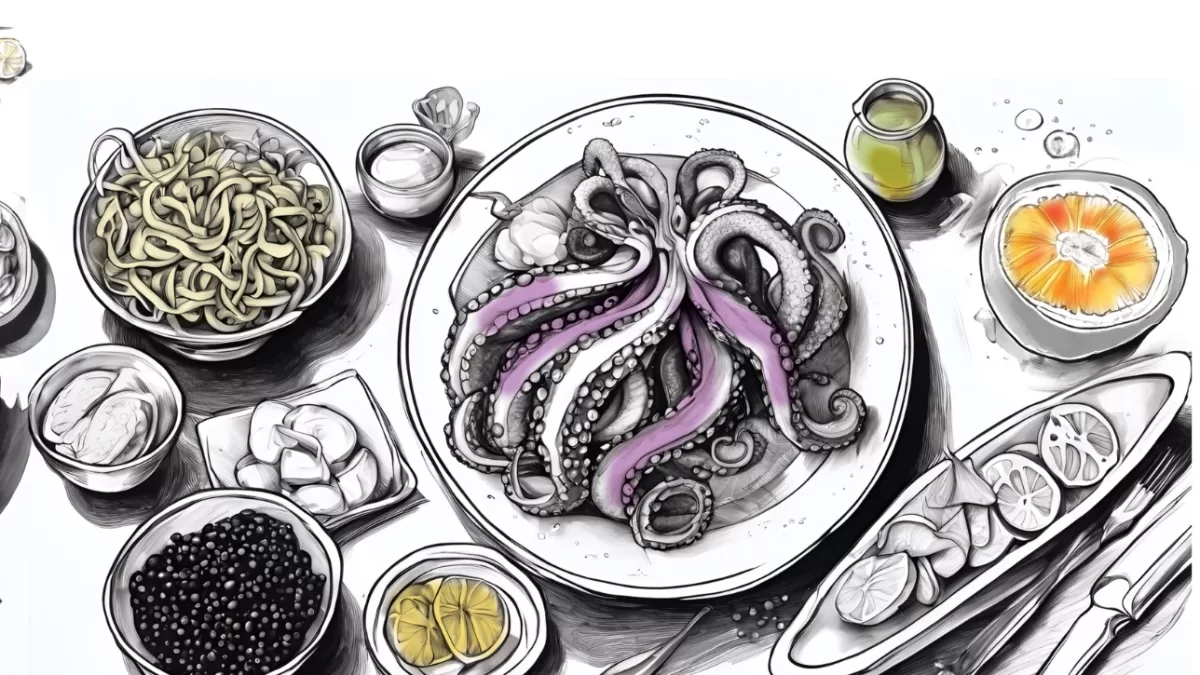
Tell me you’ve seen The Bear, FX’s emmy-nominated masterpiece about an Italian American family and a Chicago greasy spoon made good. Last season we saw our hero, Carmy, inherit a sandwich shop, struggle with making sense of family drama, and learn to live gracefully in spite of it all. This season we step inside his backstory, most notably in the talked about ‘fishes’ episode. For those of you who need further explanation, episode six of The Bear, season two, goes back in time to Carmy’s childhood home, where loved ones have gathered for the Feast of the Seven Fishes. This is a good time to clarify that most feasts aren’t as packed with drama and chaos as the aforementioned on screen depiction. Though, if you’re into that kind of thing, Jamie Lee Curtis delivers a spectacular performance guest starring as Carmy’s mother, and if there is any justice in this world she will take home some accolades during awards season. I digress.
The Feast of the Seven Fishes is an Italian American tradition celebrated on December 24, Christmas Eve, with an abundance of seafood. Traditionally, Roman Catholics abstain from meat on the eve of major holidays, and the Roman Catholic Church has been the dominant religion in Italy for over 1,500 years. The feast here in the States was started around the turn of the twentieth century by immigrants wishing to feel close to the old country. The meal consists of seven different seafood dishes, the number seven being a nod to the seven Catholic sacraments, the seven hills of Rome surrounding the city, and the seventh day of rest in the biblical creation story. Though that’s simply an educated guess, as there is no official documentation on what the number seven actually represents.
Throughout history and across cultures, the human experience has called us to gather in celebration of simply being alive. One tradition after another, we mark the passing of time. It was Joseph Campbell who postulated that tradition is simply a ritual, and what is ritual if not the reenactment of myth? At the heart of his theory is the hero’s journey, and the idea that all myths have this common theme. A hero figure leaves home, has adventures in some other place, and then returns to the community with gifts to share.
Every Feast, steeped in rich tradition, has at its heart a cast of immigrant heroes. As I contemplate their journey from the boot to Ellis Island and beyond, and how exciting and perilous and often lonely it may have been, I acknowledge their deep desire for community. Each December, as their own adventures unfolded, they came together to share recipes, stories, and hope.
It’s difficult for me to put into words how much this meal means to me and my own family and how it encapsulates the shared ancestral heritage of my husband and I. Ask anyone who knows me well what my favorite thing to talk about, shop for, or plan for is—they will tell you without hesitation it is the subject of this article. Like any holiday tradition worth its salt, the Feast of the Seven Fishes is about so much more than food—it’s about camaraderie, enhanced by music, festive decoration, love, and laughter. It’s the cultivation of sense memory: the sound of Louis Prima belting out tunes, the intoxicating smell of oil and herbs and wine and pine, the glow of candles and white lights on the tree.
For brevity’s sake, I am going to focus on the culinary pursuits my Paesans and I are about to undertake. I have family in the Midwest who do a ‘fried feast’, with offerings that include battered and oil cooked smelt, calamari, baccala salt cod, and crab cakes. I know of east coasters who do a high end lobster feast. Ours is a California kitchen hybrid, with something for everyone. Which is to say, there are many versions of the Feast of the Fishes, none of them wrong and all of them delicious.
Cook’s note: if you plan to attempt this menu, do yourself a favor and have some electric hot plates at the ready. I outline the day with a 15 minute increment schedule of events, including when some dishes are to be covered with foil and popped onto a food warmer. Others can be made in advance, such as salad dressing or parboiled risotto. Timing is everything. Finally, if you are lucky enough to be invited to such a meal, don’t be a putz and bring an eighth fish—show up with a nice panettone or tray of cannoli instead.

Let’s break it down.
Antipasto
Octopus Cold Salad
Friends, here is where I cheat. I make an early morning pilgrimage to Santa Monica Seafood for many of the necessary ingredients, at which time I buy their prepared octopus salad. It is fantastic, and I doubt I could improve upon the flavor.
Gluten-Free Calamari
Ian’s gluten free panko breadcrumbs are my go-to. The company has been on a pandemic-induced hiatus; however, their products are slowly trickling back onto shelves and into Amazon carts.
In my humble opinion, it is essential to use panko instead of traditional breadcrumbs to achieve a light, crispy texture. I also prefer to bake my calamari, as opposed to the more traditional deep frying method. Calamari turns tough when overcooked. The key is to bake slowly over low heat. Another tip? Soak in milk or lemon juice for 30 minutes prior to cooking; this helps tenderize the squid.
Amuse bouche
Caviar
There is a small shop, Absolute Caviar, tucked away in Sherman Oaks with a great selection of caviar. They have Beverly Hills and Calabasas locations as well.
Primo
Gloria’s Linguine with Clams
My mother-in-law’s recipe is always a crowd pleaser…but I can’t give away her secret!
(Editor’s Note: We do hate to disappoint so we’ve adapted a NYT Cooking recipe, using canned clams that we have found excellent for the occasion. Makes 4 to 6 servings.)
1 pound linguine
¼ cup extra-virgin olive oil
5 garlic cloves, thinly sliced
½ to 1 teaspoon red-pepper flakes
½ teaspoon dried oregano
½ cup dry vermouth or dry white wine
2-10-ounce cans whole baby clams with their juices
Salt and Black pepper to taste
2 tablespoons unsalted butter
2 teaspoons lemon zest
½ cup chopped Italian parsley
Directions: Bring a large pot of salted water to a boil. Add the pasta and cook until 2 minutes short of al dente (it will finish cooking in the sauce). Reserve ½ cup pasta water, then drain pasta.
While the pasta cooks, make your sauce: Heat the oil in a deep-sided 12-inch skillet over medium. Add the garlic, red-pepper flakes and oregano and cook until garlic is golden, 1 to 2 minutes. Add the vermouth and simmer until reduced by half, 3 to 4 minutes. Stir in the clams with their juices and cook until just warmed through, 1 to 2 minutes more.
Add the cooked pasta directly to the skillet along with the butter and lemon zest and toss until the butter has melted and the pasta is glossy with sauce. If needed, add ¼ cup reserved pasta water. Stir in half the parsley.
Serve pasta topped with a drizzle of olive oil, if desired, and the remaining parsley. Serve lemon wedges alongside if you like.
Secondo
Mediterranean Halibut
This was my father’s favorite; I used to make it for him every time my folks visited California. I don’t remember where I first came across the dish; though it is not my creation, I have made it my own. Serves four.
1 1/2 lbs halibut filets
2 cups tomatoes, canned, diced & drained
3/4 cup pitted kalamata olives
3 Tbsp capers, drained
2 Tbsp olive oil
2 garlic cloves, minced
2 shallots, minced
1 tsp good balsamic vinegar, preferably the syrupy kind
1/8 tsp red pepper flakes (optional)
6-8 fresh basil leaves, torn
Fresh ground black pepper
Directions: Heat oil in a large sauté pan over med-high heat. Lightly season fish with salt, then add filets to the pan and sear until they have gold color, about 4 mins. Turn over filets; reduce heat to low, and cook 1 min. Remove fish to a plate to keep warm.
Add garlic and shallots to the pan and cook, stirring for 1 min.
Add tomatoes, olives, capers, red pepper flakes if using, vinegar, and 1/2 tsp salt. Sauté 1 min. Increase heat to medium and simmer for 2-3 min, until vegetables are cooked through and sauce is bubbly.
Add fish back into sauce now, during the final minutes of cooking.
Transfer filets to a platter; spoon sauce over fish and sprinkle with fresh pepper and basil leaves. Serve immediately.
Grilled Jumbo Shrimp
Requires no tutorial. Marinate some large gamberi in what is essentially Italian dressing: olive oil, red wine vinegar, lemon juice, oregano, dried basil and salt & pepper. Let sit for at least one hour. Grill on skewers or in a grill basket over medium-high heat for about 2 minutes per side. Mangia!
Contorno, to accompany main course
Bitter Greens Salad
An anchovy dressing provides the final fish in our count, and is wonderful on arugula, frisée, dandelions, or chicory. I love the one from Stanly Tucci’s cookbook, The Tucci Table.
4-8 canned anchovy filets, rinsed
1 clove garlic
salt and fresh ground black pepper to taste
2 Tbsp freshly squeezed lemon juice
1/4 cup extra virgin olive oil
Special equipment: mortar & pestle
Directions: Chop the anchovies into small pieces and place them in a mortar. Using a pestle, mash them together with the garlic. Season with pepper and stir in the lemon juice. Add the olive oil and stir until emulsified. You shouldn’t need any salt thanks to the anchovies, but taste to see if you’d like to add some anyhow.
Dolce
Oranges Marinated in Liquor (recipe serves 4)
4 large oranges
1/4 cup granulated sugar
6 Tbsp orange liquor
Directions: Peel the oranges; remove as much pith as possible.
Cut the ends off the oranges; slice each one into rounds and remove the seeds.
Arrange in a dish; sprinkle with sugar and spoon liquor over fruit.
Chill for at least 1 hour, up to 12.
Please see my Spotify playlist Topanga Feast of the Fishes for accompaniment. JC






A buddy of mine directed very enjoyable film of the same name, its a perfect holiday tale:
https://www.rottentomatoes.com/m/feast_of_the_seven_fishes